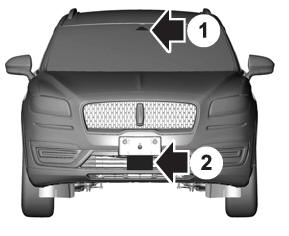Lincoln Nautilus: Climate Control System - General Information / Condenser Core Leak Check. General Procedures
Lincoln Nautilus 2018-2026 Service Manual / Electrical / Climate Control System / Climate Control System - General Information / Condenser Core Leak Check. General Procedures
Inspection
-
Recover the refrigerant.
Refer to: Air Conditioning (A/C) System Recovery, Evacuation and Charging (412-00 Climate Control System - General Information, General Procedures).
-
Disconnect the condenser from the A/C system. Refer to the appropriate
removal and installation section in Group 412 for the procedure.
-
Use the correct adapters with the A/C Service Unit to test the
condenser. The adapters are part of the A/C flushing kits. For the
correct adapters and A/C Service Unit,
Refer to: Climate Control Tools and Equipment (412-00 Climate Control System - General Information, General Procedures).
-
NOTE: The automatic shut-off valves on some hoses do not open when connected to the fittings. If available, use hoses without shut-off valves. If hoses with shut-off valves are used, make sure the valve opens when attached to the adapter fittings. The test is not valid if the shut-off valve does not open.
Connect the hoses from the A/C Service Unit to the adapter fittings on the condenser.
-
Open both valves and start the vacuum. Allow the A/C
Service Unit to vacuum for a minimum of 45 minutes after the low
pressure gauge indicates 101 kPa (30 in-Hg). The 45-minute evacuation is
necessary to remove any refrigerant from oil left in the condenser. If
the refrigerant is not completely removed from the oil, outgassing will
degrade the vacuum and appear as a refrigerant leak.
-
If the low pressure gauge reading will not drop to 101 kPa (30 in-Hg) when the valves are open and the A/C
Service Unit is operating, close the valves and observe the low
pressure reading. If the pressure rises rapidly to zero, a large leak is
indicated. Recheck the adapter fitting connections before installing a
new condenser.
-
After evacuating for 45 minutes, close the valves and
stop the service unit. Observe the low pressure gauge; it should remain
at the 101 kPa (30 in-Hg) mark.
-
If the low pressure gauge reading rises 34 or more
kPa (10 or more in-Hg) of vacuum from the 101 kPa (30 in-Hg) position in
10 minutes, a leak is indicated.
-
If a very small leak is suspected, wait 30 minutes and observe the vacuum gauge.
-
If a small amount of vacuum is lost, operate the
service unit with the valves open for an additional 30 minutes to remove
any remaining refrigerant from the oil in the condenser. Then recheck
for loss of vacuum.
-
If a very small leak is suspected, allow the system
to sit overnight with vacuum applied and check for vacuum loss.
-
If the low pressure gauge reading rises 34 or more
kPa (10 or more in-Hg) of vacuum from the 101 kPa (30 in-Hg) position in
10 minutes, a leak is indicated.
-
If the condenser leaks, as verified by the above
procedure, install a new condenser. Refer to the appropriate removal
and installation Condenser procedure in Group 412.
 Climate Control Tools and Equipment. General Procedures
Climate Control Tools and Equipment. General Procedures
Climate Control Tools and Equipment
Use the correct adapters with the Rotunda approved A/C Tools.
NOTE:
The climate control tools and equipment listed are regionally required
for Ford North America A/C service repairs...
 Electronic Leak Detection. General Procedures
Electronic Leak Detection. General Procedures
Inspection
NOTE:
Depending on refrigerant used:
Use a Rotunda-approved Electronic Leak Detector for R134a refrigerant SAE Certified to J2791...
Other information:
Lincoln Nautilus 2018-2026 Service Manual: Air Distribution Door Actuator. Removal and Installation
Removal Refer to: Passenger Knee Airbag (501-20B Supplemental Restraint System, Removal and Installation). Remove the screws and the air distribution door actuator. Disconnect the electrical connector. Installation To install, reverse the removal procedure...
Lincoln Nautilus 2018-2026 Service Manual: Front Door Window Regulator and Motor. Removal and Installation
Removal NOTE: LH side shown, RH side similar. NOTE: Removal steps in this procedure may contain installation details. NOTE: For non-functional front door window regulators and motors with the window in the 40 mm open to full closed position, cut the front door window regulator cables to allow window movement...
Categories
- Manuals Home
- 1st Generation Nautilus Owners Manual
- 1st Generation Nautilus Service Manual
- Opening the Liftgate
- Interior Lamp Function. Adjusting the Instrument Panel Lighting Brightness. Ambient Lighting. Interior Lighting – Troubleshooting
- Massage Seats
- New on site
- Most important about car
Locating the Pre-Collision Assist Sensors

If a message regarding a blocked sensor or camera appears in the information display, something is obstructing the radar signals or camera images. The radar sensor is behind the fascia cover in the center of the lower grille. With a blocked sensor or camera, the system may not function, or performance may reduce. See Pre-Collision Assist – Information Messages.
Copyright © 2026 www.linautilus.com
